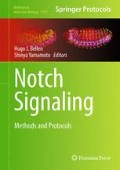Abstract
Several laboratories have developed genetic methods to monitor Notch activity in developing and adult mice. These approaches have been useful in identifying Notch signaling with high temporal and spatial resolution. This research has contributed substantially to our understanding of the role of Notch in cell specification and cellular physiology. Here, we present two protocols to monitor Notch activity in the mouse brain: (1) by intraventricular electroporation and (2) by intracranial viral injections of Notch reporter constructs. These methods allow monitoring of Notch signaling in specific brain regions from development to adulthood. In addition, using the appropriate modifications, the Notch reporter systems can also be used to monitor Notch activity in other organs of the mouse such as retina, skin, skeletal muscle, and cancer cells.
Access this chapter
Tax calculation will be finalised at checkout
Purchases are for personal use only
References
Kopan R, Ilagan MX (2009) The canonical Notch signaling pathway: unfolding the activation mechanism. Cell 137:216–233
Guruharsha KG, Kankel MW, Artavanis-Tsakonas S (2012) The Notch signalling system: recent insights into the complexity of a conserved pathway. Nat Rev Genet 13:654–666
Lathia JD, Mattson MP, Cheng A (2008) Notch: from neural development to neurological disorders. J Neurochem 107:1471–1481
Souilhol C, Cormier S, Monet M et al (2006) Nas transgenic mouse line allows visualization of Notch pathway activity in vivo. Genesis 44:277–286
Mizutani K, Yoon K, Dang L et al (2007) Differential Notch signalling distinguishes neural stem cells from intermediate progenitors. Nature 449:351–355
Nowotschin S, Xenopoulos P, Schrode N et al (2013) A bright single-cell resolution live imaging reporter of Notch signaling in the mouse. BMC Dev Biol 13:15
Ishibashi M, Moriyoshi K, Sasai Y et al (1994) Persistent expression of helix-loop-helix factor HES-1 prevents mammalian neural differentiation in the central nervous system. EMBO J 13:1799–1805
Shimizu K, Chiba S, Saito T et al (2002) Functional diversity among Notch1, Notch2, and Notch3 receptors. Biochem Biophys Res Commun 291:775–779
Ohtsuka T, Imayoshi I, Shimojo H et al (2006) Visualization of embryonic neural stem cells using Hes promoters in transgenic mice. Mol Cell Neurosci 31:109–122
Masamizu Y, Ohtsuka T, Takashima Y et al (2006) Real-time imaging of the somite segmentation clock: Revelation of unstable oscillators in the individual presomitic mesoderm cells. Proc Natl Acad Sci U S A 103:1313–1318
Vilas-Boas F, Fior R, Swedlow JR et al (2011) A novel reporter of notch signalling indicates regulated and random Notch activation during vertebrate neurogenesis. BMC Biol 9:58
Vooijs M, Ong CT, Hadland B et al (2007) Mapping the consequence of Notch1 proteolysis in vivo with NIP-CRE. Development 134:535–544
Smith E, Claudinot S, Lehal R et al (2012) Generation and characterization of a Notch1 signaling-specific reporter mouse line. Genesis 50:700–710
Ilagan MX, Lim S, Fulbright M et al (2011) Real-time imaging of Notch activation using a luciferase complementation-based reporter. Sci Signal 4:rs7
Nagy A (2000) Cre recombinase: the universal reagent for genome tailoring. Genesis 26:99–109
Gradinaru V, Thompson KR, Deisseroth K (2008) eNpHR: a Natronomonas halorhodopsin enhanced for optogenetic applications. Brain Cell Biol 36:129–139
Maillard I, Weng AP, Carpenter AC et al (2004) Mastermind critically regulates Notch-mediated lymphoid cell fate decisions. Blood 104:1696–1702
Aschauer DF, Kreuz S, Rumpel S (2013) Analysis of transduction efficiency, tropism and axonal transport of AAV serotypes 1, 2, 5, 6, 8 and 9 in the mouse brain. PLoS One 8:e76310
Fernández ME, Croce S, Boutin C et al (2011) Targeted electroporation of defined lateral ventricular walls: a novel and rapid method to study fate specification during postnatal forebrain neurogenesis. Neural Dev 6:13
Tanigaki K, Han H, Yamamoto N et al (2002) Notch-RBP-J signaling is involved in cell fate determination of marginal zone B cells. Nat Immunol 3:443–450
Acknowledgments
We would like to thank Nicholas Gaiano and Kenichi Mizutani for allowing us to reprint one of their results and for helping with the intraventricular electroporation technique. We would also like to thank Mauro Giacca and Lorena Zentilin for packaging the AAVs. This work is supported by the Swiss National Foundation, the Synapsis Foundation for Alzheimer’s Research, and Swiss Heart Association.
Author information
Authors and Affiliations
Corresponding author
Editor information
Editors and Affiliations
Rights and permissions
Copyright information
© 2014 Springer Science+Business Media New York
About this protocol
Cite this protocol
Marathe, S., Alberi, L. (2014). Monitoring Notch Activity in the Mouse. In: Bellen, H., Yamamoto, S. (eds) Notch Signaling. Methods in Molecular Biology, vol 1187. Humana Press, New York, NY. https://doi.org/10.1007/978-1-4939-1139-4_9
Download citation
DOI: https://doi.org/10.1007/978-1-4939-1139-4_9
Published:
Publisher Name: Humana Press, New York, NY
Print ISBN: 978-1-4939-1138-7
Online ISBN: 978-1-4939-1139-4
eBook Packages: Springer Protocols

